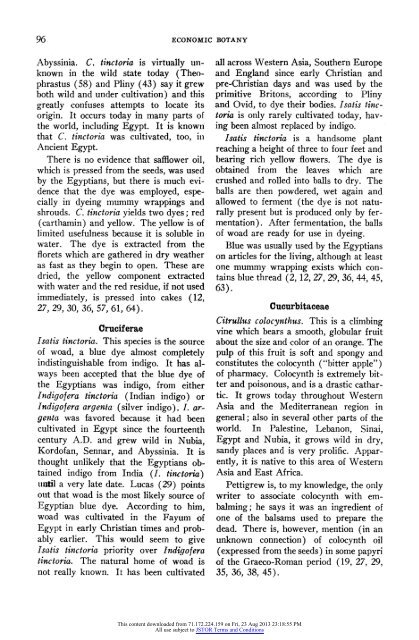The Botanical Aspects of Ancient Egyptian Embalming and Burial
The Botanical Aspects of Ancient Egyptian Embalming and Burial
The Botanical Aspects of Ancient Egyptian Embalming and Burial
Create successful ePaper yourself
Turn your PDF publications into a flip-book with our unique Google optimized e-Paper software.
96 ECONOMIC BOTANY<br />
Abyssinia. C. tinctoria is virtually uniknown<br />
in the wild state today (<strong>The</strong>ophrastus<br />
(58) <strong>and</strong> Pliny (43) say it grew<br />
both wild <strong>and</strong> under cultivation) <strong>and</strong> this<br />
greatly confuses attempts to locate its<br />
origin. It occurs today in many parts <strong>of</strong><br />
the world, including Egypt. It is known<br />
that C. tinctoria was cultivated, too, ill<br />
<strong>Ancient</strong> Egypt.<br />
<strong>The</strong>re is no evidence that safflower oil,<br />
which is pressed from the seeds, was used<br />
by the <strong>Egyptian</strong>s, but there is much evidence<br />
that the dye was employed, especially<br />
int dyeing mummy wrappings <strong>and</strong><br />
shrouds. C. tinctoria yields two dyes; red<br />
(carthamin) <strong>and</strong> yellow.: <strong>The</strong> yellow is <strong>of</strong><br />
limited usefulness because it is soluble in<br />
water. <strong>The</strong> dye is extracted from the<br />
florets which are gathered in dry weather<br />
as fast as they begin to open. <strong>The</strong>se are<br />
dried, the yellow component extracted<br />
with water <strong>and</strong> the red residue, if not used<br />
immediately, is pressed into cakes (12,<br />
27, 29, 30, 36, 57, 61, 64).<br />
Cruciferae<br />
Isatis tinctoria. This species is the source<br />
<strong>of</strong> woad, a blue dye almost completely<br />
indistinguishable from indigo. It has always<br />
been accepted that the blue dye <strong>of</strong><br />
the <strong>Egyptian</strong>s was indigo, from either<br />
Indig<strong>of</strong>era tinctoria (Indian indigo) or<br />
Indig<strong>of</strong>era argenta- (silver indigo). 1. argenta<br />
was favored because it had been<br />
cultivated in Egypt since the fourteenth<br />
century A.D. <strong>and</strong> grew wild in Nubia,<br />
Kord<strong>of</strong>an, Sennar, <strong>and</strong> Abyssinia. It is<br />
thought unlikely that the <strong>Egyptian</strong>s obtained<br />
indigo from India (I. tinctoria)<br />
untlil a very late date. Lucas (29) points<br />
otut that woad is the most likely source <strong>of</strong><br />
<strong>Egyptian</strong> blue dye. According to him,<br />
woad was cultivated in the Fayum <strong>of</strong><br />
Egypt in early 'Christian times <strong>and</strong> probably<br />
earlier. This would seem to give<br />
Isatis tinctoria priority over Indig<strong>of</strong>era<br />
tinctoria. <strong>The</strong> natural home <strong>of</strong> woad is<br />
not really known. It has been cultivated<br />
all across Western Asia, Southern Europe<br />
<strong>and</strong> Engl<strong>and</strong> since early Christian <strong>and</strong><br />
pre-Christian days <strong>and</strong> was used by the<br />
primitive Britons, according to Pliny<br />
<strong>and</strong> Ovid, to dye their bodies. Isatis tinctoria<br />
is only rarely cultivated today, having<br />
been almost replaced by indigo.<br />
Isatis tinctoria is a h<strong>and</strong>some plant<br />
reaching a height <strong>of</strong> three to four feet <strong>and</strong><br />
bearing rich yellow flowers. <strong>The</strong> dye is<br />
obtained from the leaves which are<br />
crushed <strong>and</strong> rolled into balls to dry. <strong>The</strong><br />
balls are then powdered, wet again <strong>and</strong><br />
allowed to ferment (the dye is not naturally<br />
present but is produced only by fermentation).<br />
After fermentation, the balls<br />
<strong>of</strong> woad are ready for use in dyeing.<br />
Blue was usually used by the <strong>Egyptian</strong>s<br />
on articles for the living, although at least<br />
one mummy wrapping exists which contains<br />
blue thread (2, 12, 27, 29, 36, 44, 45,<br />
63).<br />
Cucurbitaceae<br />
Citrullus colocynthus. This is a climbing<br />
vine which bears a smooth, globular fruit<br />
about the size <strong>and</strong> color <strong>of</strong> an orange. <strong>The</strong><br />
pulp <strong>of</strong> this fruit is s<strong>of</strong>t <strong>and</strong> spongy <strong>and</strong><br />
constitutes the colocynth ("bitter apple")<br />
<strong>of</strong> pharmacy. Colocynth is extremely bitter<br />
<strong>and</strong> poisonous, <strong>and</strong> is a drastic cathartic.<br />
It grows today throughout Western<br />
Asia <strong>and</strong> the Mediterranean region in<br />
general; also in several other parts <strong>of</strong> the<br />
world. In Palestine, Lebanon, Sinai,<br />
Egypt <strong>and</strong> Nubia, it grows wild in dry,<br />
s<strong>and</strong>y places <strong>and</strong> is very prolific. Apparently,<br />
it is native to this area <strong>of</strong> Western<br />
Asia <strong>and</strong> East Africa.<br />
Pettigrew is, to my knowledge, the only<br />
writer to associate colocynth with embalming;<br />
he says it was an ingredient <strong>of</strong><br />
one <strong>of</strong> the balsams used to prepare the<br />
dead. <strong>The</strong>re is, however, mention (in an<br />
unknown connection) <strong>of</strong> colocynth oil<br />
(expressed from the seeds) in some papyri<br />
<strong>of</strong> the Graeco-Roman period (19, 27, 29,<br />
35, 36, 38, 45).<br />
This content downloaded from 71.172.224.159 on Fri, 23 Aug 2013 23:18:55 PM<br />
All use subject to JSTOR Terms <strong>and</strong> Conditions
















